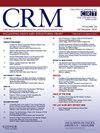合并二尖瓣或三尖瓣反流患者经导管主动脉瓣植入术的短期疗效。
IF 1.9
Q3 CARDIAC & CARDIOVASCULAR SYSTEMS
引用次数: 0
摘要
二尖瓣返流(MR)或三尖瓣返流(TR)通常是主动脉瓣狭窄(AS)患者预后不良的一个指标。我们的研究旨在比较合并MR或单独TR的患者和不合并MR或单独TR的患者经导管主动脉瓣植入术(TAVI)的结果。使用国家再入院数据库(2016-2020),我们确定了接受TAVI的严重AS患者。我们使用多变量回归进行调整分析和倾向得分匹配(PSM)模型。在315,163例因TAVI住院的患者中,14,577例(4.6%)伴有MR,而3859例(1.2%)有孤立性TR。在PSM中,TAVI伴MR与较高的急性CHF相关(50.1%对43.7%,p值0.05)。总成本较高(p值为58,104美元vs 55,183美元)本文章由计算机程序翻译,如有差异,请以英文原文为准。
Short-term outcomes of transcatheter aortic valve implantation in patients with concomitant mitral or tricuspid regurgitation
Mitral regurgitation (MR) or tricuspid regurgitation (TR) is often an indicator of poor prognosis in patients with aortic stenosis (AS). Our study aims to compare transcatheter aortic valve implantation (TAVI) outcomes in patients with and without concomitant MR or isolated TR. Using the national readmission database (2016–2020), we identified patients with severe AS undergoing TAVI. We used multivariable regression for adjusted analysis and the Propensity Score Matching (PSM) model. Among 315,163 hospitalizations for TAVI, 14,577 (4.6 %) had concomitant MR, while 3859 (1.2 %) had isolated TR. On PSM, TAVI in concomitant MR was associated with higher acute CHF (50.1 % vs 43.7 %, p-value < 0.001), mechanical circulatory support (MCS) need (1.5 % vs 0.9 %, p-value: 0.001), acute myocardial infarction (5.6 % vs. 4.3 %, p-value < 0.001) and net adverse events (61.5 % vs. 59.2 %, p-value: 0.002) while the mortality difference was not significant (p > 0.05). Higher total costs ($58,104 vs $55,183, p-value < 0.001), 90- (22.8 % vs. 21.2 %), and 180-day readmission rates (32.1 % vs. 29.4 %) were also observed [p-value < 0.05]. Similarly, TAVI in the presence of isolated TR was associated with higher cardiogenic shock (3.2 % vs. 1.8 %, p: 0.004) and MCS need (1.5 % vs 0.7 %, p: 0.009). TAVI with coexisting TR showed higher rates of 30-day (13.4 % vs. 11.2 %), 90-day (26 % vs. 21.2 %), and 180-day (34.3 % vs 29.1 %) readmission rates [p < 0.05]. A higher median length of stay (3 vs. 2 days) and total cost ($60,376 vs. $55,183) [p-value < 0.001] were also observed. TAVI in concomitant MR or TR was associated with higher periprocedural adverse events, increased healthcare burden & readmission rates.
求助全文
通过发布文献求助,成功后即可免费获取论文全文。
去求助
来源期刊

Cardiovascular Revascularization Medicine
CARDIAC & CARDIOVASCULAR SYSTEMS-
CiteScore
3.30
自引率
5.90%
发文量
687
审稿时长
36 days
期刊介绍:
Cardiovascular Revascularization Medicine (CRM) is an international and multidisciplinary journal that publishes original laboratory and clinical investigations related to revascularization therapies in cardiovascular medicine. Cardiovascular Revascularization Medicine publishes articles related to preclinical work and molecular interventions, including angiogenesis, cell therapy, pharmacological interventions, restenosis management, and prevention, including experiments conducted in human subjects, in laboratory animals, and in vitro. Specific areas of interest include percutaneous angioplasty in coronary and peripheral arteries, intervention in structural heart disease, cardiovascular surgery, etc.
 求助内容:
求助内容: 应助结果提醒方式:
应助结果提醒方式:


